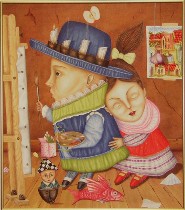 Maybe people were transfering their First Friday time to the Fringe Festival, but it seemed awfully quiet in Old City Friday evening.
Maybe people were transfering their First Friday time to the Fringe Festival, but it seemed awfully quiet in Old City Friday evening.
Other factors affecting the turnout may be the National Hardware parking lot disaster on North Second Street.
The problem on Second Street
 The first problem is the fencing in of the fence there (left), previously a popular spot for artists to mount their art en plein air. Now a second fence blocks the sidewalk, a parking lane and a lane of traffic. To put it another way, not only is the outdoor gallery gone, but the sidewalk is gone, parking on the west side of that block is practically eliminated–a disaster in a city where parking is an issue under the best of circumstances–and a busy two lane street now merges into a stop-and-go one-laner, emphasis on the stop.
The first problem is the fencing in of the fence there (left), previously a popular spot for artists to mount their art en plein air. Now a second fence blocks the sidewalk, a parking lane and a lane of traffic. To put it another way, not only is the outdoor gallery gone, but the sidewalk is gone, parking on the west side of that block is practically eliminated–a disaster in a city where parking is an issue under the best of circumstances–and a busy two lane street now merges into a stop-and-go one-laner, emphasis on the stop.
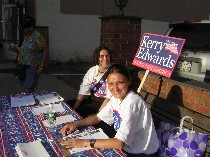 For all that bad news–another assault on gallery-owners’ livelihood by the morphing city–people put up their pro-Kerry voter-registration table (right) near Nexus and the Clay Studio, and tourists gathered around the door to the former “Real World” residence, trying to catch a glimpse of I’m not sure what.
For all that bad news–another assault on gallery-owners’ livelihood by the morphing city–people put up their pro-Kerry voter-registration table (right) near Nexus and the Clay Studio, and tourists gathered around the door to the former “Real World” residence, trying to catch a glimpse of I’m not sure what.
The Cubans
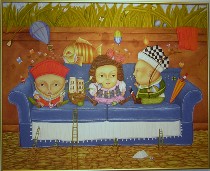 In Gallery Siano, the work of two Cuban-born artists covered the walls. Fuentes Ferrin’s surreal paintings and drawings seemed like what “Alice in Wonderland” illustrator John Tennial might have produced had he been raised on Cuban rum. They mixed sweetness and fantasy with soupcons of the grotesque (images, top of post, “Muse in Love,” and left, “My Backyard is Private”).
In Gallery Siano, the work of two Cuban-born artists covered the walls. Fuentes Ferrin’s surreal paintings and drawings seemed like what “Alice in Wonderland” illustrator John Tennial might have produced had he been raised on Cuban rum. They mixed sweetness and fantasy with soupcons of the grotesque (images, top of post, “Muse in Love,” and left, “My Backyard is Private”).The colors in the thinly applied oils tend to hot-house primaries, giving the imagery an innocence that fits the imagery to a tee. The black-and-white drawings are mostly ink on paper, with a couple in pencil (right below, “Filomeno”).
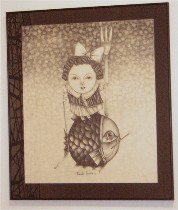 The subject matter seems to be love and family and daily life and who knows what else transformed by the magic of imagination and memory. I’d call it magical realism if it were a little more realistic, but what’s realistic about that work is not how it looks but the emotions it conveys–the pleasures of relationships and the sense of life as well as people are something to be embraced.
The subject matter seems to be love and family and daily life and who knows what else transformed by the magic of imagination and memory. I’d call it magical realism if it were a little more realistic, but what’s realistic about that work is not how it looks but the emotions it conveys–the pleasures of relationships and the sense of life as well as people are something to be embraced.
Ferrin is Cuba-educated and has been in the United States only about four years, but has been involved in a number of group shows in Miami since his arrival.
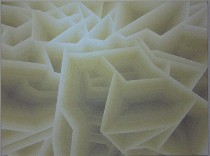 Alex Queral’s education was in this country, and Roberta and I had seen his phone-book portraits at the Painted Bride earlier this year in “Used: New Work from Old Things,” curated by Shelley Spector (Roberta’s post here). Imagine my surprise in finding this newer work was completely abstract–large paintings of straight, hard-edge lines creating space and the illusion of light, expressing a kind of yearning for something beyond. Several of the paintings were either grisaille or monochromatic, and Queral writes, were “influenced by the basic graphic look of comic books.”
Alex Queral’s education was in this country, and Roberta and I had seen his phone-book portraits at the Painted Bride earlier this year in “Used: New Work from Old Things,” curated by Shelley Spector (Roberta’s post here). Imagine my surprise in finding this newer work was completely abstract–large paintings of straight, hard-edge lines creating space and the illusion of light, expressing a kind of yearning for something beyond. Several of the paintings were either grisaille or monochromatic, and Queral writes, were “influenced by the basic graphic look of comic books.”
Queral, who has an MFA from Penn, has taught locally at Moore College and Penn.
Politics and dogs
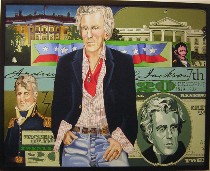 At LaPelle, W.T. Williams’ show, “Eye on America,” in the second room of the gallery, crowds the walls with 95 paintings of several ilks.
At LaPelle, W.T. Williams’ show, “Eye on America,” in the second room of the gallery, crowds the walls with 95 paintings of several ilks.
His collage-like portraits of political figures from the past can barely contain themselves within the canvases on which they are painted. He’s got George Washington, Thomas Jefferson, Abraham Lincoln, Ullysses S. Grant, etc., etc., all dressed up in modern garb and surrounded by images of the money that memorializes them as well as their signatures and portraits from the past.
In this political season, I happily tested myself to see which ones I could recognize. The names of the paintings, eg. “George: 1-1-25” decoded, represent the portrait subject named in the modern way, first name only, with which number president he was (1), which paper currency denomination he ornaments (1), and which coin he ornaments (25) (shown, “Andrew: 7-20-0”).
What I liked about these paintings besides their energy, was their way of poking a little fun of the way we have deified these figures from our past and then bringing them into the modern world. In a way, they’re puzzle paintings, letting you search through them to find what you can.
But politics weren’t Williams’ only body of work, which ranges from traditional to pop.
Best in show
Best in show were the iconic doggie portraits, one more wacky and more beautiful than the next. The dogs stare you down, their wrinkly skin becoming formal folds like the fabric drapes on saints in altar tryptichs. Williams surrounds the animals with painted borders and dresses them in outfits befitting their personas.
And speaking of saints, Williams confided that one woman, who had asked him to paint her Rotweiller, said the dog was a saint. “So I painted him like a saint,” he said.
I asked him if the dogs sat still for their portraits, but Williams said he worked from photos. “Of course they’re not dressed,” he said of the dogs in the photos.
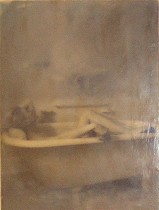 Anyway, I’d commission a painting of my dog if I had a dog and were a dog person. These capture the doting dog lover’s idolization of their pooches with some humor that undercuts a kitschiness so extreme it gathers gravitas.
Anyway, I’d commission a painting of my dog if I had a dog and were a dog person. These capture the doting dog lover’s idolization of their pooches with some humor that undercuts a kitschiness so extreme it gathers gravitas.
In the front room at Lapelle were encaustic sepia-toned nudes by Leah MacDonald that come straight out of Victorian nudie photographs. The technique was great, the subject matter questionable. But I suspect there are folks out there who might eat this up (urp, excuse me) (left, “Cloud”).
Portraits of metal
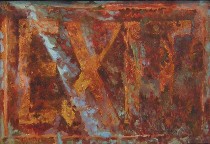 I also want to mention some paintings of machinery and abandoned-looking metal junk by Ed Marston at Muse Gallery. Marston got in a touch of politics in “Exit Strategy,” a painting of an old, found rusty exit sign. He said he was referring to the lack of exit strategy in Iraq.
I also want to mention some paintings of machinery and abandoned-looking metal junk by Ed Marston at Muse Gallery. Marston got in a touch of politics in “Exit Strategy,” a painting of an old, found rusty exit sign. He said he was referring to the lack of exit strategy in Iraq.
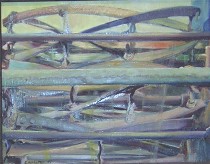 Other outstanding pieces included “Norman’s Garage” (left) and “Blast Furnace.” The quality of his junk piles and abandoned or non-standard spaces were filled with unexpected color and compassion.
Other outstanding pieces included “Norman’s Garage” (left) and “Blast Furnace.” The quality of his junk piles and abandoned or non-standard spaces were filled with unexpected color and compassion.









